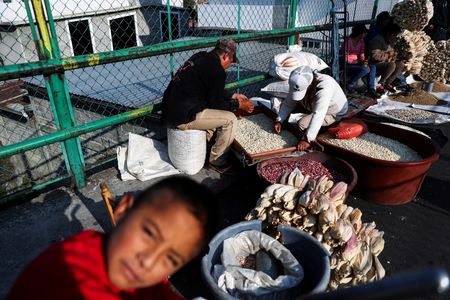By Gabriel Burin
BUENOS AIRES (Reuters) – Mexico’s economy will likely slow in step with an expected moderation of growth in the United States, but the decline could be limited by increased investment from companies relocating to the Latin American country, a Reuters poll showed.
Gross domestic product (GDP) in Mexico expanded more than forecast from the second half of 2022 to the start of this year, as low unemployment supported private consumption and remittances hit record highs, driving a strong “super” peso.
However, the region’s second-largest economy after Brazil is set to decelerate in coming quarters along with an anticipated cooling in the U.S. following a string of rate hikes by the Federal Reserve that is expected to draw to an end.
Mexican GDP growth will probably fall from 2.3% this year to 1.5% in 2024, according to the median estimates among 30 analysts polled in the July 10-20 period. This still would represent an upgrade for the two years combined, from the forecasts in the April poll of 1.5% and 1.6%, respectively.
“Although consumption has slowed, it remains close to all-time highs due to rising real wages, greater optimism from lower inflation, a stronger exchange rate, and government transfers,” said Banco Base analyst Gabriela Siller.
The Mexican central bank is expected to hold its key interest rate at a record 11.25% until the last three months of 2023, when a small cut of 25 basis points is anticipated, as inflation stays relatively elevated close to the 5.0% mark then.
“So far, the interest rate level has not impacted economic activity … growth in coming quarters could be affected more by a slowdown in the United States, Mexico’s main trading partner,” said Ricardo Aguilar, chief economist at Invex.
Analysts noted that moves to relocate production to Mexico from China could add a boost. “If ‘nearshoring’ begins to materialize this year, we see annual growth rates of 3.0% (in 2023) and above 2% in 2024,” economists at Finamex said.
Nearshoring refers to the trend to move production closer to North American buyers and away from Asia, where supply-chain snarls during the coronavirus pandemic overshadowed the region’s low-cost advantage.
On the negative side, Latin America is facing risks from the El Nino weather pattern, which is marked by a warming of water temperatures in the Pacific Ocean that may reignite food inflation and hit crops. Some initial impact has already occurred in Peru and other Andean nations.
At the same time, the effects of a credit crunch induced by the longest period of hawkish monetary policy among top economies are reappearing in Brazil, where estimates pointed to a possible GDP growth reduction from 2.2% in 2023 to 1.5% next year.
The downtrend should be offset by rising social spending which, in theory, could be paid for with additional tax revenues stemming from planned fiscal reforms the government wants to present next month, including measures affecting the wealthy.
Argentina’s economy, however, is expected to worsen, with the poll showing a consensus call for a 3.3% GDP contraction this year and a 0.5% drop in 2024, versus forecasts of a 2.3% fall and 1.0% rise, respectively, in April’s poll.
The Peronist government is seeking relief from the International Monetary Fund, as Argentina battles a severe financial crisis that could be aggravated by a lack of international reserves.
(Reporting by Gabriel Burin in Buenos Aires; additional reporting by Isabel Woodford in Mexico City; Editing by Paul Simao)





